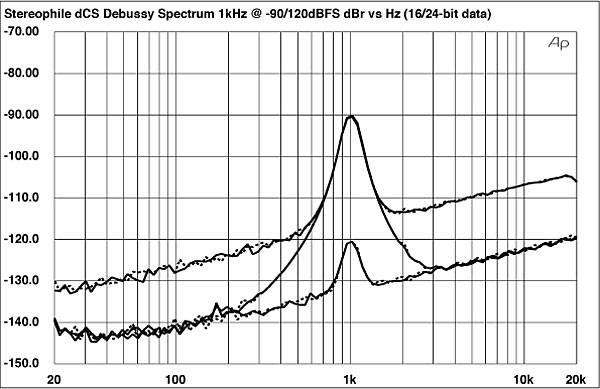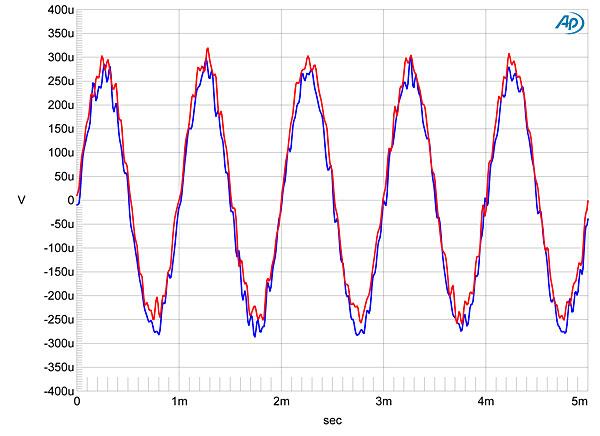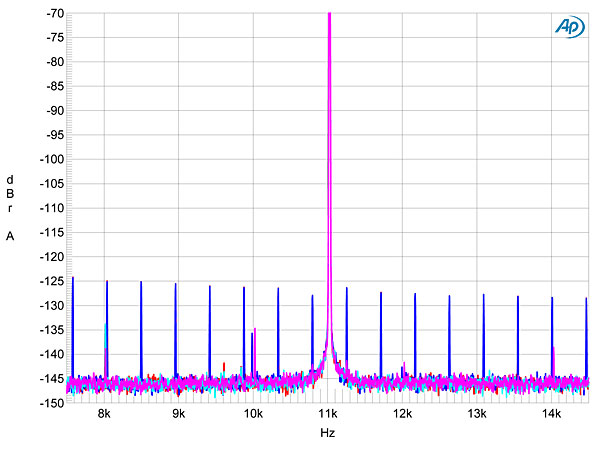| Columns Retired Columns & Blogs |
Why ???
Cheers George
I mostly used Stereophile's loan sample of the top-of-the-line Audio Precision SYS2722 system to perform the measurements on the dCS Debussy (see www.ap.com and the January 2008 "As We See It"); for some tests, I also used my vintage Audio Precision System One Dual Domain and the Miller Audio Research Jitter Analyzer. To test the Debussy's performance via its USB input, I used my MacBook running OS10.6 and Bias Peak Pro 6 to play WAV files of the various test signals I use. Apple's USB Prober utility identified the Debussy as being a "dCS Debussy\000\000\000\000\000\000" manufactured by "Data Conversion Systems Ltd," and confirmed that it operated in "isochronous asynchronous" mode, as specified. The bit depth on offer was 24, and the sample rates capable of being accepted via USB were 32, 44.1, 48, 88.2, and 96kHz.
The maximum output level at 1kHz was 2.0V or 6.12V, depending on the position of the rear-panel switch, and was identical from the balanced and unbalanced output jacks. Both sets of outputs preserved absolute polarity (ie, were non-inverting) when the front-panel Phase LED was off. (The XLR jacks are wired with pin 2 hot.) The output impedance was to specification at all audio frequencies, at 52 ohms single-ended and around 1 ohm balanced. Channel separation (not shown) was superb, at >115dB in both directions below 6kHz.
The Debussy offers a choice of reconstruction low-pass digital filters. The first, with the front-panel Filter LED off, is a conventional linear-phase FIR type, with a typical time-symmetrical impulse response (fig.1). With the Filter LED illuminated, the filter is a minimum-phase type, with no pre-ringing in its impulse response (fig.2). Despite this very different time-domain behavior, the filters offer identical performance in the frequency domain. Fig.3 shows the Debussy's frequency response with the linear-phase filter and data with sample rates of 32, 48, 96, and 192kHz. (The Debussy's AES/EBU and S/PDIF inputs will accept data with sample rates up to only 96kHz; for 176.4 and 192kHz data, the connection must be made using both its AES/EBU inputs in parallel.) As expected, the response drops sharply just below half each sample rate, but with a gentle overall rolloff above the audioband.

Fig.1 dCS Debussy set to Filter 1, response to single sample at 0dBFS, 44.1kHz-sampled data (4ms time window).

Fig.2 dCS Debussy set to Filter 2, response to single sample at 0dBFS, 44.1kHz-sampled data (4ms time window).

Fig.3 dCS Debussy, frequency response at –12dBFS into 100k ohms from balanced outputs with data sampled at: 32, 48, 96, 192kHz (left channel blue, right red; 0.25dB/vertical div.).
For consistency with my published tests of digital components, my initial test of resolution is performed using a 1/3-octave bandpass filter swept from 20kHz to 20Hz while the device under test decodes data representing a dithered 1kHz tone at –90dBFS. The top pair of traces in fig.4 was taken with 16-bit data; the traces peak at exactly –90dB, implying very low linearity error, and are free from harmonic or power-supply–related spuriae. The noise floor is actually the dither noise used to encode the signal; increasing the signal's word length to 24 bits drops the noise floor by almost 18dB (middle traces), suggesting that the Debussy has at least 19 bits' worth of resolution, which is close to the state of the art. It readily resolves a dithered tone at –120dBFS (fig.4, bottom traces).

Fig.4 dCS Debussy, 1/3-octave spectrum with noise and spuriae of dithered 1kHz tone at –90dBFS with 16-bit data (top) and 24-bit data (middle), and of dithered tone at –120dBFS with 24-bit data (right channel dashed).
Fig.5 repeats this test using an FFT technique and the very-high-resolution converters in the Audio Precision SYS2722. Again, the increase in bit depth drops the noise floor by around 18dB, and a very small spike is apparent at 180Hz in the left channel (blue trace). At –143dB (0.000008%), this is not going to upset listeners! All of the tests so far were performed using AES/EBU data. Repeating these analyses with the same data via the Debussy's USB input gave identical results, confirming that it correctly handles 24-bit data via USB. Linearity error with 16-bit data (fig.6) was minimal to below –110dBFS, and the Debussy correctly decoded an undithered 16-bit tone at exactly –90.31dBFS, with the three DC voltage levels clearly resolved, the waveform symmetrical, and the filter ringing not obscured by analog noise (fig.7). This graph was taken with the linear-phase filter; changing to the minimum-phase filter gave the change in the transient ringing expected from fig.2 (fig.8). With undithered 24-bit data, the Debussy gave a good facsimile of a sinewave (fig.9), confirming its excellent low-level resolution and its very low level of analog noise.

Fig.5 dCS Debussy, FFT-derived spectrum with noise and spuriae of dithered 1kHz tone at –90dBFS with: 16-bit data (left channel cyan, right magenta), 24-bit data (left blue, right red).

Fig.6 dCS Debussy, linearity error, dBr vs dBFS, 16-bit data (2dB/vertical div.).

Fig.7 dCS Debussy, Filter 1, waveform of undithered 1kHz sinewave at –90.31dBFS, 16-bit data (left channel blue, right red).

Fig.8 dCS Debussy, Filter 2, waveform of undithered 1kHz sinewave at –90.31dBFS, 16-bit data (left channel blue, right red).

Fig.9 dCS Debussy, Filter 1, waveform of undithered 1kHz sinewave at –90.31dBFS, 24-bit data (left channel blue, right red).
As with other dCS products I have tested, the Debussy's analog output stage was bombproof. Even driving the demanding 600 ohm load at full level, the balanced output produced negligible harmonic distortion (fig.10), with the second harmonic at –110dB (0.0003%) and the third at –113dB. Only with the high-frequency intermodulation test did I get somewhat anomalous results: Although actual intermodulation is extremely low in level, the noise floor looks granular (fig.11). I repeated this test using a different software package but got the same result. I can only assume that this granularity has something to do with the DSD upsampling algorithm used by the Debussy.

Fig.10 dCS Debussy, spectrum of 50Hz sinewave, DC–1kHz, at 0dBFS into 600 ohms (left channel blue, right red; linear frequency scale).

Fig.11 dCS Debussy, HF intermodulation spectrum, DC–24kHz, 19+20kHz at 0dBFS into 100k ohms (linear frequency scale).
Finally, the Debussy offers superb rejection of jitter via both its AES/EBU and S/PDIF inputs and via USB, so I am not sure why MF found the two input modes to sound different from one another. Fig.12 was taken with the J-Test data in both 16-bit (blue and red traces) and 24-bit (cyan and magenta) versions. The odd-order harmonics of the low-frequency squarewave with 16-bit data (blue) are at the residual level without any accentuation; with 24-bit data, almost all that can be seen are the noise floor and the central spike representing the 11.025kHz tone. The same is true for the Debussy tested via its USB input (fig.13).

Fig.12 dCS Debussy, high-resolution jitter spectrum of analog output signal, 11.025kHz at –6dBFS, sampled at 44.1kHz with LSB toggled at 229Hz, 16-bit data via AES/EBU (left channel blue, right red); 24-bit data via AES/EBU (left cyan, right magenta). Center frequency of trace, 11.025kHz; frequency range, ±3.5kHz.

Fig.13 dCS Debussy, high-resolution jitter spectrum of analog output signal, 11.025kHz at –6dBFS, sampled at 44.1kHz with LSB toggled at 229Hz, 16-bit data via USB (left channel blue, right red). Center frequency of trace, 11.025kHz; frequency range, ±3.5kHz.
It was a pleasure to test such a superbly engineered product as the dCS Debussy. Its measured performance is close to the state of the art and the fact it includes a true asynchronous USB input is a bonus.—John Atkinson